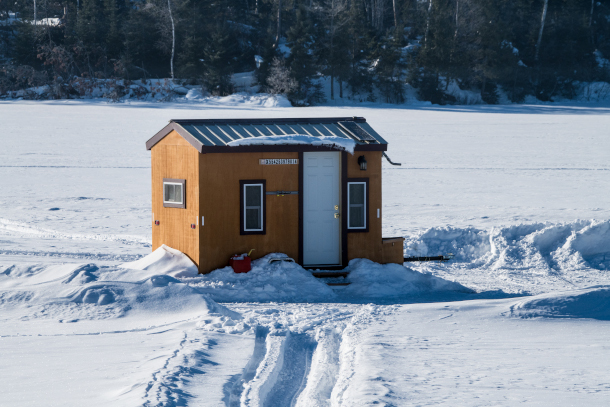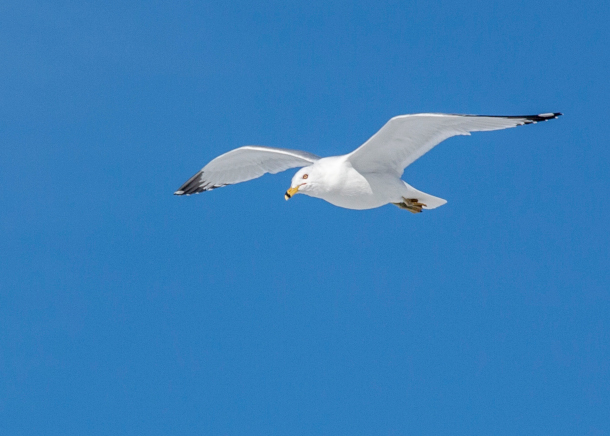Ice Fishing on a Tidal River
Air Date: Week of February 3, 2023

A yellow ice shack located on Shagawa Lake in the Superior National Forest in Minnesota. (Photo: Lance Cheung, Forest Service USDA, Public Domain)
Winter can be cold and dark, but the bright light reflected from frozen lakes, ponds, and streams can be cheery and warm. And that's the secret of ice fishing. Mark William Damsel explains the joys of ice fishing on a frozen river in this audio postcard from Living on Earth's Bobby Bascomb.
Transcript
BASCOMB: With the cold and dark of winter in the north, these months can begin to feel like something to endure but for many the best way to get through winter is to find something to look forward to when the temperature drops. And for Mark William Damsel that something is ice fishing. I met up with him last year on the Exeter River in New Hampshire as he was busy working outside his ice shack.
DAMSEL: We just moved the shack, cut a new hole. You can see there's like, I got a tape measure, but I'd say that's at least 14 inches of ice. So what happens is this, see how this has got a black roof? The sun heats this shack up and usually during the day on a sunny day it'll be 65 degrees with no heat in this shack. It actually melts the ice underneath the shack. So what we do is you put two by fours up underneath here to keep the ice cold. So the ice shack doesn't actually melt into the water.
And we got the grill going we got some hot dogs to eat because we've been working so hard.
Usually, you don't catch them during the day. It's always better fishing at night for one reason or another. So right now the tides going down because this is a tidal river, goes with the ocean. Usually, the incoming tide just before high like an hour or two before the high tide, and then an hour or two as the tide goes out. You catch ‘em. But I've caught ‘em during the day the night afternoon. My motto is you can't catch them on the coach.
The river actually pushes the tide up. But there's so much ice and snow and weight down here. Last Sunday the water couldn't push the ice up. All the ice shacks that were down here last weekend. The water came up through our holes and we all had about a foot of water inside of a shack.
So now that we got the ice, ice shack, cut in the hole, so to speak, you can see all the shacks have rope on them. So you drill a hole and you get a piece of wood and you put it up underneath the ice. And then you tie off your shack because most of the shacks are real light. And if you get a wind it will blow them down the river. This one is so light I live up the street, seven, eight years ago, it blew all the way down in the marsh we had to go rescue it.

A right billed gull flapping its wings in the bright blue sky (Photo: Paul VanDerWerf, Wikimedia Commons, CC BY 2.0)
My father, grandfather and great grandfather grew up right close to the proximity of the river. So I've fished all my life on the river. When I was a child, I can remember when there was abundance of smelt that we used to actually shovel them into grain bags. That was before the day there was no limit. Now there's only a four-quart limit, so you only can take four quarts a day. There haven't been many fish, so things have changed. I believe it's global warming, climate change and pollution as contributing to the decline in the smelt population.
There's about a dozen shacks down here. And it's all a bunch of old, you know, older fellows and a couple young fellows that just come down here and have a good time. I don’t know what the great word is but I look forward to it every year. It's a lot of fun. It's peaceful. It's neat. You see, we just seen the bald eagle down here a little while ago. The seagulls wait for us to catch fish so we can feed them too. We've got the grill going we're gonna have some hot dogs and some food in a little bit once we get this thing set up and it's all good.
BASCOMB: That’s ice fisherman Mark William Damsel on the Exeter River in New Hampshire.
Links
ENVIRONMENTAL FACT SHEET: The Exeter and Squamscott Rivers
Living on Earth wants to hear from you!
Living on Earth
62 Calef Highway, Suite 212
Lee, NH 03861
Telephone: 617-287-4121
E-mail: comments@loe.org
Newsletter [Click here]
Donate to Living on Earth!
Living on Earth is an independent media program and relies entirely on contributions from listeners and institutions supporting public service. Please donate now to preserve an independent environmental voice.
NewsletterLiving on Earth offers a weekly delivery of the show's rundown to your mailbox. Sign up for our newsletter today!
 Sailors For The Sea: Be the change you want to sea.
Sailors For The Sea: Be the change you want to sea.
 The Grantham Foundation for the Protection of the Environment: Committed to protecting and improving the health of the global environment.
The Grantham Foundation for the Protection of the Environment: Committed to protecting and improving the health of the global environment.
 Contribute to Living on Earth and receive, as our gift to you, an archival print of one of Mark Seth Lender's extraordinary wildlife photographs. Follow the link to see Mark's current collection of photographs.
Contribute to Living on Earth and receive, as our gift to you, an archival print of one of Mark Seth Lender's extraordinary wildlife photographs. Follow the link to see Mark's current collection of photographs.
 Buy a signed copy of Mark Seth Lender's book Smeagull the Seagull & support Living on Earth
Buy a signed copy of Mark Seth Lender's book Smeagull the Seagull & support Living on Earth

